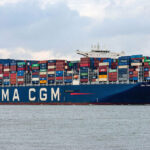
Carriers want to raise Asia rates again
16.05.2025In view of the expected cargo declines in China during Golden Week in early October, carriers are now preparing for significant capacity reductions starting as early as the end of the month. By temporarily canceling departures, the carriers are signaling their determination to avert a price collapse at the end of the peak season.
The Chinese port of Qingdao at the end of August. (Photo: IMAGO / VCG)
September 2, 2024 | by Michael Hollmann
In view of the expected cargo declines in China during Golden Week in early October, carriers are now preparing for significant capacity reductions starting as early as the end of the month. According to an analysis by the market research firm Sea-Intelligence, the departure cancellations announced so far on the main routes are roughly the same as in the years 2017 to 2019 before the coronavirus pandemic. On the Far East to Northern Europe route, capacity cuts throughout October will average 16.9 percent, or roughly one-sixth. At their peak, more than 30 percent of regular slots will be lost in the second week of October, according to the report. Since carriers still have several weeks to finalize their plans, further adjustments are expected, and the cancellation rate may even increase further.
For the Far East/Mediterranean route, Sea-Intelligence estimates a market-wide capacity reduction of 14.1 percent in the four weeks beginning October 1. In the transpacific trade, the analysts estimate the capacity cuts will be 10.1 percent on the Far East to the US West Coast route and 13.2 percent on the Far East to the US East Coast route. Compared to 2023, the cancellations are significantly smaller: Last October, the capacity decreased by 23 to 27 percent, depending on the trade. However, the conditions were also completely different.
Last year, the market was burdened by significant overcapacity, freight rates had fallen back to pre-pandemic levels and were under massive pressure. This year, however, the container fleet is fully utilized due to the long detours around the Cape of Good Hope, and rates from the Far East remain significantly elevated. Only in recent weeks have freight rates slowly come down from their annual highs. Last Friday, the Shanghai Index (SCFI), which tracks spot rates on 13 routes out of China, fell by 4.3 percent to around 2,963 points. This marks the first time since May that the market barometer has fallen below the 3,000 mark. However, the level is still three times higher than exactly a year ago. With the planned temporary rationalizations, the carriers are now signaling their determination to avert a price collapse at the end of the peak season, rather than carrying as much cargo as possible at the still-high rates for as long as possible.
How the freight market develops into the fall will likely depend largely on what happens on the cargo side. According to the British data provider Container Trades Statistics (CTS), global container transport volumes typically decline seasonally by just under 2 percent starting in September. This year, however, the short-term decline could be more severe if it is confirmed that importers in North America and Europe have brought forward procurement and transport on a large scale due to the tense situation. The latest economic indicators for the Eurozone countries continue to paint a very bleak picture. The Purchasing Managers’ Index for the manufacturing sector remained unchanged at 45.8 points in August, thus remaining below the neutral mark of 50 for over two years. According to the EU Commission, consumer confidence in the Eurozone deteriorated by 0.4 percentage points to minus 13.4 percent, also remaining below the long-term average. (alb)



